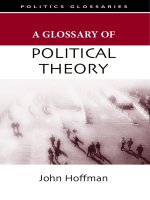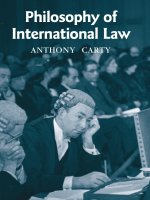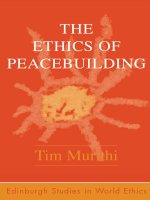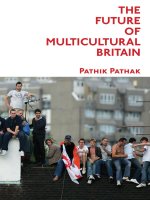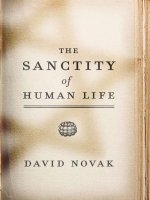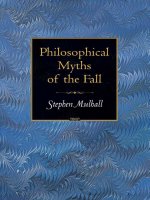edinburgh university press the future of multicultural britain confronting the progressive dilemma oct 2008
Bạn đang xem bản rút gọn của tài liệu. Xem và tải ngay bản đầy đủ của tài liệu tại đây (906.47 KB, 225 trang )
THE FUTURE OF MULTICULTURAL BRITAIN Pathik Pathak Edinburgh
This book identifi es two key themes:
• That contemporary global politics has rendered many of the world’s
democracies susceptible to the rhetoric and policy of majoritarianism;
• That majoritarianism plays on popular anxieties that invariably gravitate
towards cultural identity.
Global politics are deeply affected by issues surrounding cultural identity.
Profound cultural diversity has made national majorities increasingly
anxious and democratic governments are under pressure to address
those anxieties. Multiculturalism – once heralded as the insignia of
a tolerant society – is now blamed for encouraging segregation and
harbouring extremism.
Pathik Pathak makes a convincing case for a new progressive politics that
confronts these concerns. Drawing on fascinating comparisons between
Britain and India, he shows how the global Left has been hamstrung by
a compulsion for insular identity politics and a stubborn attachment to
cultural indifference. He argues that to combat this, cultural identity
must be placed at the centre of the political system.
Written in a lively style, this book will engage anyone with an interest in
the future of our multicultural society.
Pathik Pathak is a lecturer and writer on Comparative Politics, based at
the CRUCIBLE Centre for Human Rights, Citizenship and Social Justice
Education at the University of Roehampton.
ISBN 978 0 7486 3545 0
Edinburgh University Press
22 George Square
Edinburgh EH8 9LF
www.euppublishing.com
Cover photograph: The Fifth Test: England v Australia – Day Five;
phot
ographer Clive Rose; reproduced with permission of Getty Images.
Cov
er design: Barrie Tullett
THE FUTURE OF
MULTICULTURAL BRITAIN
Confronting the Progressive Dilemma
Pathik Pathak
THE
FUTURE
OF
MULTICULTURAL
BRITAIN
Pathik Pathak
The Future of Multicultural Britain
Multicultural Britain
Confronting the Progressive Dilemma
Pathik Pathak
Edinburgh University Press
# Pathik Pathak, 2008
Edinburgh University Press Ltd
22 George Square, Edinburgh
Typeset in 11/13pt Linotype Sabon by
Iolaire Typesetting, Newtonmore, and
printed and bound in Great Britain by
CPI Antony Rowe, Chippenham, Wilts
A CIP record for this book is available
from the British Library
ISBN 978 0 7486 3544 3 (hardback)
ISBN 978 0 7486 3545 0 (paperback)
The right of Pathik Pathak to be identified as author
of this work has been asserted in accordance with
the Copyright, Designs and Patents Act 1988.
Contents
Acknowledgements vii
Glossary of Indian Terms ix
Introduction 1
1. The Trouble with David Goodhart’s Britain: 33
Liberalism’s Slide towards Majoritarianism
2. Saffron Semantics: 62
The Struggle to Define Hindu Nationalism
3. Spilling the Clear Red Water: 94
How we Got from New Times to New Liberalism
4. The Blame Game: 122
Recriminations from the Indian Left
5. Making a Case for Multiculture: 158
From the ‘Politics of Piety’ to the Politics of the Secular?
Conclusion 187
Index 205
Firstly, much gratitude to David Dabydeen for his guidance and
comments during the completion of my Ph.D. thesis, and also to
Neil Lazarus for his direction and assistance. Many thanks to my
wonderful examiners, Stephen Chan and the choti boss Rashmi
Varma, whose comments and suggestions led to this publication.
We only formed during the last two years of my Ph.D. but the
camaraderie of my cronies Jim Graham, Mike Nibblet, Sharae
Deckard, Kerstin Oloff and Jane Poyner was invaluable. Thanks
to Pranav Jani and Thomas Keenan for their help in enriching my
knowledge of previously unexplored disciplines. That extends to
the Birmingham Postcolonial Reading Group too.
Kavita Bhanot’s contributions have been empathy and a remark-
able ability to take thrashings at badminton with good humour
but bad language. I salute Ivi Kazantzi, Theo Valkanou, Bibip
‘BJ’ Susanti, Giovanni Callegari, Letisha Morgan, Celine Tan and
especially Nazneen Ahmed for helping to stave off intellectual
alienation.
Aisha Gill has been as supportive and enthusiastic as any col-
league could be, and the time and space I’ve been given to finish this
book are a consequence of CRUCIBLE’s generosity. I’d also like to
thank my students at Southampton and Roehampton.
viii Acknowledgements
Lois ‘Bambi’ Muraguri, take a bow. Without your constant
support, patience and encouragement over the past three years
none of this would have possible at all. Heartfelt appreciation goes
to my Ma for steering me through the most crucial passage of my
Ph.D., and to Dad for abusing his printing privileges time and again
for my sake. I owe my brother Manthan a debt of gratitude for his
efforts at reading through my work.
This book is dedicated to the thousands of victims of the Gujarati
pogroms in 2002 and my adorable nieces Hema and Ciara, whom I
pray grow up in more secular and equal times.
Journal acknowledgement
Chapter 1, ‘The Trouble with David Goodhart’s Britain’, has
appeared as a journal article in Political Quarterly, 78: 2 (2007).
Glossary of Indian Terms
adivasi Indigenous minorities in India, populous in the states of
Orissa, Madhya Pradesh, Chattisgarh, Rajasthan, Gujarat, Maha-
rashtra, Andhra Pradesh, Bihar, Jharkhand and West Bengal.
Babri Masjid Otherwise known as the Babri Mosque or Babur’s
Mosque, it was constructed by the Mughal Emperor Babur in
the city of Ayodhya, on the alleged site of a Rama temple that
consecrated the deity’s birthplace.
Bajrang Dal Literally, the ‘Army of Hanuman’. The youth wing of
the Vishwa Hindu Parishad (VHP).
Bharatiya Janata Party (BJP) Literally, the ‘Indian People’s Party’.
A right-wing nationalist political party, formed in 1980. It is
unified with other organisations affiliated to the Sangh Parivar
through the ideology of Hindutva.
dalit The name given to those who fall outside the Indian caste
system, who are also referred to as untouchables.
dharma In Indian morality and ethics, a term that refers to the
underlying natural order, and the laws that support it.
fatwa Historically, a ruling on Islamic law, issued by an Islamic
scholar. In the contemporary world it has been appropriated by
Islamic extremists to refer to an edict concerning a perceived
contravention of Islamic law.
x Glossary of Indian Terms
Ganchi A Gujarati minority, native to Godhra, the site of the
petrol-bombing of the Sabarmati Express.
Hindutva Literally, ‘Hindu-ness’. The unifying ideology of the
Sangh Parivar, espousing Hindu nationalism.
Janata Party (JP ) A political party that contested and won the
1977 Lok Sabha (general elections), defeating the Indian
National Congress for the first time in India’s democratic
history. It was a rainbow coalition whose constituent members
included the B haratiya Jana Sangh (‘Indian People’s Alliance’),
which was closely associated with the Rashtriya Swayamsevak
Sangh.
kar sevak A volunteer for a religious cause, commonly associated
with Hindutva.
Lok Sabha Literally, the ‘People’s House’. India’s lower parlia-
mentary house.
madrassa Islamic seminaries.
mandir The Hindi term for a temple.
masjid The Arabic term for a mosque.
pracharak Full-time worker of the Rashtriya Swayamsevak
Sangh.
Ramjanmabhoomi The supposed site of the birthplace of Lord
Rama. It also refers to the movement to demolish the Babri
Masjid, which was alleged to have been constructed on the site,
demolishing an existing Hindu temple in the process.
rashtra Used in the term ‘Hindu rashtra’, to denote a Hindu
polity.
rath yatra In its purest form, a chariot procession.
Sangh Parivar Literally, the ‘Family of Associations’. The con-
glomerate of organisations ideologically united by Hindutva.
sarva dharma sambhava Denotes the validity of all religions,
and is used as the grounds for religious freedoms in the Indian
constitution.
shakha Cell, commonly used to refer to the branches of the
Rashtriya Swayamsevak Sangh, which number over 50,000 in
India.
Shiv Sena Literally, ‘Army of Shiva’, a Hindu and Marathi
chauvinist political party, founded by Bal Thackeray.
swadeshi Literally, ‘self-sufficiency’, a campaign popularised dur-
ing the Gandhi-led independence movement
Swaraj movement The movement for self-rule in colonial India.
trishul Indian trident, often mounted on a stick.
Glossary of Indian Terms xi
United Progressive Alliance (UPA) The name of the Indian gov-
ernment’s presently ruling coalition, formed soon after the 2004
general elections.
Vishwa Hindu Parishad (VHP) Literally, the ‘World Hindu
Council’, an offshoot of the RSS, the ‘socio-cultural’ arm of
Sangh Parivar, and with influential branches in the UK, North
America and East Africa.
Scene 1: Oldham, Bradford and Burnley, summer 2001
At the dawn of New Labour’s second term, when they were
returned to power with a daunting parliamentary majority, a
cascade of civil unrest in England’s northern towns stunned Britain.
Even before the cataclysmic events of 11 September that year,
multiculturalism had been battered and British tolerance towards
minorities had stiffened. Though the ‘race riots’ have been eclipsed
by the sensationalising implications of the so-called war on terror
and receded from historical centre stage, they provided political
capital for an assimilationist revival that has been unambiguously
attributed to the threat of Islamic fundamentalism.
Britain was alerted to the latent violence in Oldham on 23 April
2001. Walter Chamberlain, a 76-year-old World War Two veteran,
was hospitalised after a savage beating at the hands of three Asian
youths. He had been walking home after watching a local amateur
rugby league match and was alleged to have breached the rules of
Oldham’sracialised cartography by entering a ‘no-go’ area for whites.
He was set upon by the youths for an unauthorised incursion onto
Asian territory.
The attack viscerally confirmed the emergence of a new social
2 The Future of Multicultural Britain
problem: minority racism. The rise to power of Asian racists, in
particular, preoccupied the local media. Oldham’s racial problems
were stated to have been ‘inspired’ and ‘perpetrated’ by Asians who
were said to ‘be behind most racial violence’. Statistics were
wheeled out to prove this disturbing fact: Oldham police logged
600 racist incidents in 2000, and in 60 per cent of them, the victims
were white. Of these 600, 180 were described as violent with the
vast majority inflicted by Asian gangs of anywhere between ‘six and
twenty’ on ‘lone white males’.
1
The attack on Chamberlain galvanised the National Front which
held abortive attempts to march on three consecutive Saturdays. On
21 May, violence erupted between Asian youth and police in the
Glodwick area. Though the police diverted the rioters away from
the town centre, there was serious collateral damage to business,
cars and residential property. Pubs were firebombed and windows
smashed; there were even allegations of an assault on an elderly
Asian woman.
What happened in Oldham was repeated in Burnley and Brad-
ford. Both Asian- and white-owned pubs were torched in Burnley,
with many burnt out. BBC plans to interview British National
Party (BNP) leader Nick Griffin in Burnley were dropped amidst
the violence. Like Oldham Chronicle editor Jim Williams, Griffin
was still afforded a BBC platform, in a telephone interview on
Radio 4’s Today programme, to blame the violence on ‘Asian
thugs’ for ‘winding this up’ by ‘attacking innocent white people’.
This contradicted the findings of an official report into the violence,
which found that some of Burnley’s white population had been
‘influenced’ by the BNP, and that Asian rioting took place in
retaliation for an attack on an Asian taxi driver the preceding
night. The report, entitled Burnley Speaks, Who Listens?, con-
cluded that three nights of rioting was the result of machinations
to elicit competition between rival criminal gangs into racial con-
frontation.
Bradford was the next town to fall, stung by violence over three
nights in early July. Two people were stabbed, 36 arrested and 120
police officers injured during the first two nights, which mainly
occurred in the predominantly Asian area of Manningham. On the
third it subsided into a stand-off between Asian youths and police.
No one in Bradford can complain about being unprepared,
though. The far-Right National Front and paramilitary Combat
18 had stalked the city for weeks preceding the general election,
Introduction 3
agitating in proxy for the BNP. And they had devised techniques to
ratchet up the tension, honed in Oldham. While police were tied up
with a rally composed of the main body of members, splinter
groups would scamper to wreak havoc in Asian areas. The in-
tention was to provoke Asian youth into retaliatory violence. If
Oldham had become an ‘open city’, ripe for a bloody ‘race war’,
Bradford was next in line. By the time the tension combusted into
rioting, Asian youth had been worked into a frenzy and they craved
the opportunity for retribution. Stores of petrol bombs were col-
lected and gangs coalesced. One such gang named itself Combat
786 – the numerical representation of Allah.
A report by Lord Herman Ousley, former head of the Commis-
sion for Racial Equality (written several weeks before the violence
in Burnley or Bradford), criticised Bradford’s leaders for failing to
confront racial segregation, particularly in schools, which, as in
Oldham, were either 99 per cent white or 99 per cent Muslim. He
warned that the consequence of the authorities’ inaction was a city
in ‘the grip of fear’.
A separate ind ependen t report into the Oldham disturbances
accused the council of failing to act on ‘deep seated’ issues of
segregation. It also blamed racial tension o n insensitive and
inadequate p olicing and an administr ative power structure that
failed to represent Asian communities. Only 2.6 per cent of
Oldham’s council (the town’s largest employer) was staffed by
ethnic minorities. At a press conference announcing the report, its
chair considered ethnic minority under-repres entation to be ‘a
form of institu tional racism’, evidence of an unwillingness to face
realities.
2
The riots fomented hostilities which broke new electoral ground
for the far Right. The BNP capitalised on crisis in the north-west,
saving five deposits and picking up over 10 per cent of the vote in
three constituencies across Oldham. Its biggest success was deliv-
ered to its leader Nick Griffin, who gained over 16 per cent of the
vote in one seat. In another the BNP took over 11 per cent of the
poll off the back of an election campaign which encouraged voters
to ‘boycott Asian business’.
Scene 2: Gujarat, spring 2002
What happened in the western Indian state of Gujarat almost
twelve months later was both more calculated and of a radically
more barbaric order. In the words of Arundhati Roy, Gujarat was
4 The Future of Multicultural Britain
no less than the ‘petri dish in which Hindu fascism has been
fomenting an elaborate political experiment’.
3
Gujarat’s communalisation began in earnest when the the Sangh
Parivar’s political wing, the Bharatiya Janata Party (BJP), assumed
state power in 1998.
4
In its first year in power, in coordination with
its extra parliamentary militia, the Vishwa Hindu Parishad (VHP)
and the Bajrang Dal, the BJP began to poison relations between the
majority Hindus and Gujarat’s religious minorities. In the first half
of 1998 alone, there were over forty recorded incidents of assaults
on prayers halls, churches and Christian assemblies as a systematic
attempt to terrorise Gujarat’s Christian community was mounted.
Baseless claims of Christianisation and the trafficking of Hindu girls
to Asia’s Islamic bloc were propagated by the agencies of the Sangh
Parivar with the connivance of the Gujarati press.
5
In January 2000 the BJP’s paranoia was given legislative expres-
sion. A bill against religious conversion was proposed to the
Gujarat state assembly, even though it directly contravened an
article of the Indian constitution. Gujarat was the apogee of
decimated secularism and feverish majoritarianism whipped up
by an extremist state government. The hostility between Gujarat’s
increasingly vulnerable Muslims and its ideologically frenzied
Hindus combusted on the Sabarmati Express at the religiously
segregated town of Godhra on the morning of 27 February 2002.
On board the train were no less than 1,700 kar sevaks or ‘holy
workers’ returning from the proposed site of a Rama temple at
Ayodhya – the spark for nationwide rioting ten years earlier. The
area immediately beneath the railway station was populated by
‘Ganchis’, largely uneducated and poor Muslims who were notor-
ious participants in previous bouts of communal violence.
Alleged provocation from the kar sevaks (abuse of Ganchi
vendors, the molestation and attempted abduction of a Muslim
girl) resulted in a fracas on the platform between Ganchis and
sevaks. But when the train pulled away fifteen to twenty minutes
later, it was immediately halted when the emergency chain was
pulled. A mob of 2,000 Ganchis had been hastily gathered from the
immediate vicinity. They began pelting coaches S5 and S6 (spec-
ulation is that the offending kar sevaks were concentrated in those
coaches) with firebombs and stones. S6 suffered the brunt of the
missile attack: it was burnt out leaving the carcasses of 58 passen-
gers, including 26 women and 12 children. Most of the able-bodied
kar sevaks are believed to have escaped either to adjacent coaches
Introduction 5
or out of the train altogether. Godhra’s incendiary precedent set the
genocidal tone for several days of calculated pogroms.
Sixteen of Gujarat’s twenty-four districts were stricken by
organised mob attacks between 28 February and 2 March, during
which the genocide was concentrated.
6
They varied in size from
between five and ten thousand, armed with swords, trishuls
(Hindu tridents) and agricultural instruments. While official gov-
ernment estimates of the dead speculated at 700 deaths, unofficial
figures start at 2,000 and keep rising.
7
Incited by a communalised
media and government which branded Muslims as terrorists,
Hindus embarked on a four-day retaliatory massacre. Muslim
homes, businesses and mosques were destroyed. Hundreds of
Muslim women and girls were gang-raped and sexually mutilated
before being burnt alive. The stomachs of pregnant women were
scythed open and foetuses ripped out before them. When a six-
year-old boy pleaded for water, he was made to forcibly ingest
petrol instead. His mouth was prized open again to throw a lit
match down his throat.
After consideration of all the available evidence at the time, an
Independent Fact Finding Mission concluded that the mass provi-
sion of scarce resources (such as gas cylinders to explode Muslim
property and trucks to transport them) indicated ‘prior planning of
some weeks’. In the context of that revelation, the Godhra incident
was merely an excuse for an anti-Muslim pogrom conceived well in
advance. The pattern of arson, mutilation and death by hacking
was described by one report as ‘chillingly similar’ and suggestive of
pre-meditated attack.
8
Dozens of eyewitnesses corroborate this
theory, since many of the attacks followed an identical design.
Truckloads of Hindu nationalists arrived clad in saffron uniforms,
guided by computer-generated lists of Muslim targets which
allowed them to ransack, loot and pillage with precision even in
Hindu-dominated areas.
9
The sheer speed of the genocide indicts
Narendra Modi’s BJP government. Without extensive state sanc-
tion (of which partisan policing has proven to be the thin edge) the
violence could have been contained within the three days that Modi
disingenuously claimed it had. In many cases, police were witnessed
actually leading charges, providing covering fire for the rampaging
mobs they were escorting.
10
It is also undeniable that Modi’s and the BJP’s reaction
contributed to a climate of retribution. When asked about the
retaliatory violence, Modi inanely echoed Rajiv Gandhi eighteen
6 The Future of Multicultural Britain
years earlier, quoting Newton’s third law that ‘every action has an
equal and opposite reaction’.
11
He even commended Hindu Gujar-
atis on their restraint on 28 February – when the killing was at its
most prolific and the rampage at its most devastating. Given
Gujarat’s anger at the events of Godhra he believed ‘much worse
was expected’. He later likened Muslim relief camps to ‘baby
making factories’, promising to teach ‘a lesson’ to those ‘who keep
multiplying the population’.
12
The pogrom drove over a hundred thousand Muslims into
squalid makeshift refugee camps. Many of these were on the sites
of Muslim graveyards, where the living slept side by side with
the dead. The internally displaced were deprived of adequate
and timely humanitarian assistance: sanitation, medical and food
aid were in short supply in the supposed ‘relief’ camps. Non-
governmental organisations, moreover, were denied access to
redress the shortfalls of essential provisions. The systematic decima-
tion of the Muslim community’s economic basis was compounded
by the emaciation of its surviving population.
The institutional failure to protect Muslim life did not end there.
Despite immediate government boasts of thousands of arrests,
many of those detained were subsequently released on bail, pending
outstanding trials, acquitted or simply let go.
13
Human Rights
Watch (2003) research suggests that very few of those culpable
for the genocide are in custody: the vast majority of those behind
prison bars are either Dalits (untouchables), Muslims or adivasis
(tribals). Modi retains ministerial control of Gujarat.
Muslims, on the other hand, have borne the brunt of the rule of
law. Over a hundred Muslims implicated in the attack on the
Sabarmati Express have been detained under the controversial
Prevention of Terrorism Act (POTA), India’s equivalent of Britain’s
new terror laws.
Of communities and citizens
Weeks after the Gujarat massacre, at the Bangalore session of its
annual convention, the Rashtriya Swayamsevak Sangh (RSS) – the
ideological father of the BJP and the ‘moral and cultural guild’ of its
top brass – passed a resolution that unless minorities ‘earn the
goodwill of the majority community’, their safety could not be
guaranteed.
14
Notwithstanding the fact that they were the over-
whelming victims of the carnage, or that it was they who were left
intimidated, vulnerable and unprotected in its aftermath, the RSS
Introduction 7
believed that the burden of reconciliation and security should fall
on Muslim shoulders.
In Britain, the political post-mortem was equally swift and
equally skewed. Within months of the disturbances, newly ap-
pointed home secretary David Blunkett had categorically attributed
the retaliations of British-born, second-generation Asian youth
(actually to neo-fascist provocation) to the consequence of a poor
facility with English and a failure to adopt British ‘norms of
acceptability’.
15
It was culturally inassimilable minorities who
had ‘failed’ British society. Minority responsibilities assumed rheto-
rical centre stage in both instances.
By juxtaposing these incongruous episodes I am not trying
to draw facile similarities between civil unrest and orchestrated
genocide. Comparisons are grotesque given the disproportion
between the incidents at Bradford, Burnley and Oldham and those
at Ahmedabad, Vadodara and Surat.
16
It is not the similarity of the
two incidents, or the two nations that was compelling. Instead, it
was the shifting social attitudes towards minorities and the fact of
cultural diversity that made such a comparison fascinating.
What both incidents indicated, across their disparate spaces, was
a novel reflex of the (liberal and non-liberal) nation-state to
demonise minorities as inassimilable communities and a disinclina-
tion to recognise them as citizens. The distinctions being drawn
were between communities as illegitimate collective actors and
citizens as individuals acting in the interests of the national good.
Both cases, though through radically different degrees and
dynamics, were expressions of actual or latent majoritarianism.
And, most crucially, they were occurring in societies with a histor-
ical commitment to multiculturalist policies. What was intriguing
was the correspondence between a declining multiculturalism and
an ascendant majoritarianism. How were the two related?
They were particularly complex distinctions to be drawn at a
time when community was being politicised in very different ways
in Britain and India. In both cases, protection for minorities has
been displaced by the aggrandisement of the majority community,
circumscribed by conspicuously cultural parameters. The state’s
patronage of plural cultural communities has given way to the
mandate for a single communitarian order: the seeds of majoritar-
ianism. The double focus of this latent majoritarianism balances the
coercive imperative for minorities to disaggregate as individuals
with the enactment of government strategies to heighten the
8 The Future of Multicultural Britain
boundaries of an imagined national common culture. As New
Labour’s White Paper Secure Borders: Safe Haven (2002) makes
plain, citizens should only tolerate newcomers if their own identities
are ‘secure’.
17
Political rights and responsibilities therefore cor-
respond to individuals’ positions either inside or outside these
boundaries.
While Blairism has been premised on the bedrock of neighbourly
communitarianism it had become increasingly anxious about the
contradictions between secular and religious communities for social
cohesion. Rather than address the causes of segregation in diverse
conurbations like Bradford, Birmingham and Leicester, Britain’s
political centre has grown increasingly strident in its displeasure at
the failure of some minority groups to ‘integrate’. A commonplace
expression of this exasperation has been the description of non-
integrated minorities as ‘communities’, a description that has been
politically contorted from celebration (under multiculturalism) to
condemnation (the new assimilationism).
By figuring ethnic minorities as communities the British centre
and Right have consciously avoided recognising individuals ‘inside’
these formations as citizens; on the contrary they have designated
ethnic minorities as ‘trainee Brits’ at an earlier evolutionary stage of
citizenship. Closeted within culturally impermeable communities,
minority individuals are precluded from identification with the
‘common good’, a realisation of their identities as national citizens
and their active participation in the aspirations of the nation.
The divestment of individuality from minorities has accentuated
their responsibilities to the nation (even as their rights have been
attenuated). Settled ethnic minorities have been placed under new
obligations and expectations to be ‘active citizens’ to build on
‘shared aims across ethnic groups’, to avoid extremism and respect
national values. The prevalence of the minority community has
become the excuse under which citizenship has become more
prescriptive and demanding than ever.
For the Sangh Parivar’s ideological movement, the distinction
between the inassimilable community and the patriotic citizen has
been strategically central. Hindutva rests on the assumption that
India is a Hindu nation (more precisely a Hindu land with a view to
becoming a Hindu nation) whose citizens are those who cherish
it as their fatherland and their holy land.
18
As believers in the
‘Hindu-ness’ (as Hindutva translates into English) of the Indian
nation its citizens form an ‘integral’ community on that basis.
Introduction 9
Despite differences between its limbs and organs, the body politic
and social are all oriented towards the well-being of the whole.
Members of religious minorities who refuse to accept India’s Hindu
genius cannot therefore be citizens; they are identified as commu-
nities external to the nation.
The Bharatiya Janata Party has long argued that the ‘pseudo-
secularism’ of successive Congress ‘comprador’ governments has
baited the Hindu majority by repeatedly pandering to religious-
minority communities. It has pointed to political opportunism that
has created ‘vote-banks’ among religious minorities to be manipu-
lated according to electoral calculations. But as much as govern-
ments have been condemned for exploitative politicking, the greater
accusation is that Muslim communities have been able to act
collectively – through block voting – to unfairly influence the
democratic process, gain political advantage and optimise their
communal power.
Muslim communities have also been harangued by the RSS and
its executive organs for exercising patriarchal communitarianism:
suppressing individual choices and forcing women to be veiled and
housebound. By refusing contraception and failing to control
family sizes they have been accused of draining India’s resources
with excessive population growth. Secularism’s failures can also be
explained by their intransigence and intolerance. Anti-modern and
culturally backward, Indian Muslims are constructed ‘as the source
and the dislocation of the Indian nation’, ‘stunting the economic
growth and dynamism of the country’.
19
The riots in the north of England and the Gujarati pogroms were
ugly eruptions, stoked in the hothouses of British neo-assimilation-
ism and Hindu nationalism. Though the latter took place at the
height of Hindutva’s powers while multiculturalism’s reversal of
fortune was only just beginning, they were both visceral symptoms
of a declining confidence in existing regimes of minority govern-
ance, and the accompanying attenuation of national identity. But
this doesn’t merely take the form of a popular backlash against
minority appeasement; as I’ve shown, it’s an attitude that is
sustained and even promoted by state agencies and the media. I
call it the majoritarian reflex.
The majoritarian reflex
This reflex draws its strength from the isolation of so-called
minority blocs from mainstream society by expressing exasperation
10 The Future of Multicultural Britain
at the reluctance of those communities to ‘integrate’. Majoritarian-
ism exploits popular anxieties, which are inflated into a mandate
for the rightward shift of the political centre. The principal casualty
of this shift is a weakened commitment – and in some circumstances
an outright refusal – to recognise the cultural and religious rights of
minorities. ‘Multiculturalism’ is pilloried as anathema to secular
culture and the values of liberal democracy. The fact of cultural
diversity itself is (sometimes spuriously) indicted for a host of social
problems, from crime and disorder to the fragility of the welfare
state (as we’ll see in the discussion of the work of David Goodhart).
This is often, but not always, compounded by a licence to rear-
ticulate democratic rights in accordance with new political impera-
tives. In its most extreme forms, minorities are incriminated not
only for sheltering illiberal values and practices and failing to act as
citizens in the interests of the national good, but also in their social
presence as communities for unravelling the very fabric of secular
culture.
What I am careful to emphasise is the range of the majoritarian
repertoire; it will not always beget pogroms. But it always seeks to
bring cultural diversity into disrepute, and always seeks to privilege
majority interests over those of the minority. The extent to which
this mutates the terms of democratic debate, legal protection and
social tolerance will vary from nation to nation. My argument is
that it is a growing threat that succeeds where progressive politics
fails to engage in a coherent way with ideas of community and
culture.
The progressive dilemma
The second strand to this book addresses what, for the sake of
convenience, I refer to as the progressive dilemma. Many intellec-
tuals have claimed to voice this dilemma. In recent debates in
Britain it has been used to denote the trade-off between diversity
and solidarity. I use it in a different sense here. While majoritarian
ideologies and imaginaries are a proliferating threat to democratic
society, the extent of their credibility will depend on how effectively
a progressive answer to cultural diversity emerges from what
remains of the Left, as both an intellectual and a political formation.
To this end the questions that followed Gujarat and Bradford,
Burnley and Oldham were not solely about state responses but
equally about the reaction from secular and anti-racist politicians,
intellectuals, activists and organisations. In which language, and by
Introduction 11
what means, would they assert the rights of the violated? How
would they speak in the defence of the victims, and how would they
seek to mobilise public opinion?
These are the questions that preoccupy this book, described in
short as facing up to the ‘progressive dilemma’. I have defined this
as an ethical question for those who oppose the majoritarian reflex:
what role, if any, should progressive voices play in pre-emptively
addressing popular anxiety on issues usually reserved for conser-
vatives, racists or bigots? This, in turn, is framed by other questions,
such as how far should the Left move towards the orthodox
territory of the Right before it becomes culpable for nurturing
majoritarian instincts? How can we judge the efficacy of progres-
sive interventions at all? This is how I evaluate the likely fortunes of
cultural diversity; not as a predestined casualty of expanding
majoritarianism, but as a contingent outcome of the inclination
of progressive politics. I therefore invest considerable optimism
in the ability of oppositional politics to renew itself, and the
constitutive role of political agency at an individual level in shaping
large-scale social attitudes.
To prepare for my treatment of the progressive dilemma I will
now introduce the configurations of majoritarianism that currently
(or threaten to) prevail in Britain and India respectively.
British majoritarianism
Britain’s regression from liberal multiculturalism to liberal assim-
ilationism has, like India’s degradation of secularism, been in-
cremental and propelled by a crisis of the Left. The British
establishment’s initial reluctance to allow Commonwealth immi-
gration, despite the acute post-war shortages in the public sector,
governed official and public attitudes to race relations until Roy
Jenkins salutary (if over-determined) intervention in 1967. Until
then racism was understood as a peculiar form of xenophobia, the
result of the archetypal dark-skinned stranger disorientating the
startled Anglo-Saxon population. The working assumption, as
Jenny Bourne put it, was that ‘familiarity would breed content’.
20
It was not until Jenkins interjected with his vision of ‘equal
opportunity accompanied by cultural diversity in an atmosphere
of mutual tolerance’ that the face of race relations acquired liberal
characteristics. Equal opportunity was treated with the soporifics of
the Race Relations Acts of 1965 and 1968 that gravitated towards
conciliation rather than prosecution. Racism was given renewed
12 The Future of Multicultural Britain
respectability with the 1968 Kenyan Asians Act, which barred the
free entry to Britain of its citizens on the simple grounds that they
were Asian. Exceptions were those with a parent or grandparent
‘born, naturalised or adopted in the UK’ – as presumably would be
the case if they were born in geographically ‘familial’ places like
Australia or New Zealand. Racism was further institutionalised in
the state with the Immigration Act of 1971 when all primary non-
white immigration was stopped dead. The right to abode was
restricted to Commonwealth citizens of demonstrable Anglo-Saxon
stock, known as ‘patrials’.
Given the impotence of the race relations legislation and the
respectability afforded to racist discrimination with the new
immigration acts, Jenkins’ multiculturalist vision was eventually
distilled to the common sense that coloured people were likely to be
just as disorientated by emigration as whites by immigration. The
solution was to satisfy these ostensibly psychological needs by
granting immigrants their own cultural spaces and institutions
where they could cocoon themselves, away from the alienating
swirl of mainstream society.
If the state was willing to tolerate cultural diversity (however
ambivalently that tolerance might be manifested) it was compla-
cently hoped that this would drip-feed through society. The public
recognition of difference, rather than a hard line on racism, was the
state’s concession to liberals and immigrants.
Racism was concluded to be a matter of personal prejudice: a
character trait to be weaned away by cultivating cultural respect.
The logic of mainstream anti-racism was given full expression in the
judicial inquiry into the Brixton riots of 1981, headed by Lord
Scarman. Scarman rejected out of hand (and against the weight of
evidence) accusations that institutional racism was prevalent in the
Metropolitan police force. Though Scarman broke the news that
racial ‘discrimination’ and ‘disadvantage’ continued to plague
Britain’s minorities, he offered no novel wisdom to challenge them.
His prescription was higher doses of political correctness and
broader strategies towards moral anti-racism. Racial awareness
training (RAT) was intensively and enthusiastically undertaken
throughout local authorities to weed out personal prejudice.
Scarman’s recommendations were the furthest the Thatcherite
establishment was willing to move in anti-racist directions during
its three terms in power. Thatcher’s diminution and inflation
of state and personal responsibility was indicative of her policy
